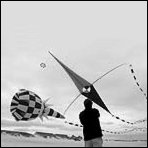

As a further illustration, imagine that you are a subject in a psychology experiment in which you are shown a long sequence of pictures of familiar objects. The pictures represent various things, and each one may be shown many times. You are asked from time to time to predict what the next few images will be, and you keep trying to construct mental schemata for the sequence, inventing theories about how the sequence is structured, based on what you have seen. Any such schema, supplemented by the memory of the last few pictures shown, permits you to make a prediction about the next ones. Typically, those predictions will be wrong the first few times, but if the sequence has an easily grasped structure, the discrepancy between prediction and observation will cause you to reject unsuccessful schemata in favour of ones that make good predictions. Soon you may be foreseeing accurately what will be shown next.
Now imagine a similar experiment run by a sadistic psychologist who exhibits a sequence with no real structure at all. You are likely to go on making up schemata, but this time they keep failing to make good predictions, except occasionally by chance. In this case the results in the real world afford no guidance in choosing a schema, other than the one that says, "This sequence seems to have no rhyme or reason."
But human subjects find it hard to accept such a conclusion.
Now imagine a similar experiment run by a sadistic psychologist who exhibits a sequence with no real structure at all. You are likely to go on making up schemata, but this time they keep failing to make good predictions, except occasionally by chance. In this case the results in the real world afford no guidance in choosing a schema, other than the one that says, "This sequence seems to have no rhyme or reason."
But human subjects find it hard to accept such a conclusion.
Murray Gell-Mann

The kakapo is a bird out of time. If you look one in its large, round, greeny-brown face, it has a look of serenely innocent incomprehension that makes you want to hug it and tell it that everything will be all right, though you know that it probably will not be.
In fact the kakapo is a bird that in some ways reminds me of the British motorbike industry. It had things its own way for so long that it simply became eccentric. The motorbike industry didn't respond to market forces because it wasn't particularly aware of them. It built a certain number of motorbikes and a certain number of people bought them and that was that. It didn't seem to matter much that they were noisy, complicated to maintain, sprayed oil all over the place and had their own very special way, as T.E. Lawrence discovered at the end of his life, of going round corners. That was what motorbikes did, and if you wanted a motorbike, that was what you got. End of story.
In fact the kakapo is a bird that in some ways reminds me of the British motorbike industry. It had things its own way for so long that it simply became eccentric. The motorbike industry didn't respond to market forces because it wasn't particularly aware of them. It built a certain number of motorbikes and a certain number of people bought them and that was that. It didn't seem to matter much that they were noisy, complicated to maintain, sprayed oil all over the place and had their own very special way, as T.E. Lawrence discovered at the end of his life, of going round corners. That was what motorbikes did, and if you wanted a motorbike, that was what you got. End of story.
Douglas Adams

There were places, some of the old monks believed, that acted as filters for the world's woes, catching and holding the torments that drifted across the earth. Maybe here was such a place, Shan thought, where the screams and cries of the millions below collected to be beaten by the wind into snippets of sound, like pebbles in a river.
Eliot Pattison
|
Flowers, birds, and insects are common design motifs for kimono. Unlike more abstract patterns, or representations of such auspicious objects as fans, the natural objects usually have a seasonal significance. Some are expressly associated with a particular month - pine for January, plum for February, iris for May - but most are more broadly appropriate for a season: cherry blossoms in the spring, little trout for summer, or maple leaves in the fall. Colors can also have seasonal flavors. Traditional color combinations, for the most part named after flowering plants, are specific to each month. For example, January's colors are pale green layered on deep purple. The combination is called pine. October's are rose backed with slate blue, called bush clover. These are preeminantly cultural categories, for although the names of the combinations - pine, peach, cicada wing, artemesia, and so on - reflect a connection to the natural world, the colors themselves have little to do with the name. May's combination, called mandarin orange flower (the actual blossom of which is white), consists of purple and a color known as deadleaf yellow. Liza Dalby |

Although the precise origins of kites are lost in legend, the first recorded reference comes from China in about 500 BC, when a craftsman built what was probably a wooden bird kite. The early Chinese kites were magnificent constructions of silk and bamboo, but with the introduction of cheap paper around the second century AD, the kite became more widely available; many festivals and games based on kite-flying were born.
Paul & Helene Morgan
One of the most colourful of kiting pioneers is surely Samuel Franklin Cody, an American who settled in England. In 1901, he patented a winged version of a double-celled box kite, which was used for man-lifting. Other exploits included a kite-powered crossing of the English Channel. Despite his keenness to put his inventions to practical use, he was not taken seriously by the military: his long hair and Wild West show made him too unconventional. However, in 1906, he was given officer status at Farnborough, England, where he built the Cody war kites. He was also the first man in Britain to fly an aeroplane. He met his death in 1913 when another of his creations broke up in flight.

T
his is the room of the wolfmother wallpaper. The toadstool motel you once thought a mere folk tale, a corny, obsolete, rural invention.
This is the room where your wisest ancestor was born, be you Christian, Arab, or Jew. The linoleum underfoot is sacred linoleum. Please remove your shoes. Quite recently, the linoleum here was restored to its original luster with the aid of a wax made from hornet fat. It scuffs easily. So never mind if there are holes in your socks.
This is the room where your music was invented. Notice the cracked drumhead spiked to the wall, spiked to the wolfmother wallpaper above the corner sink where the wayward wife washed out her silk underpants, inspecting them in the blue seepage from the No Vacancy neon that flickered suspiciously out in the lizard dawn.
What room is this? This is the room where the antler carved the pumpkin. This is the room where the gutter pipes drank the moon light. This is the room where moss gradually silenced the treasure, rubies being the last to go. Transmissions from insect antennae were monitored in this room. It's amazing how often their broadcasts referred to the stars.
A clue: this is the room where the Painted Stick was buried, where the Conch Shell lay wrapped in its adoring papyrus. Lovers, like serpents, shed their old skin in this clay room. Now do you remember the wallpaper? The language of the wallpaper? The wolfmother's blood roses that vibrated there?
Enough of this wild fox barking. You pulled up in the forest Cadillac, the vehicle you claimed you'd forgotten how to drive. You parked between the swimming pool and the row of blackened skulls. Of course, you know what room this is.
This is the room where Jezebel frescoed her eyelids with history's tragic glitter, where Delilah practiced for her beautician's licence, the room in which Salome dropped the seventh veil while dancing the dance of ultimate cognition, skinny legs and all.
This is the room where your wisest ancestor was born, be you Christian, Arab, or Jew. The linoleum underfoot is sacred linoleum. Please remove your shoes. Quite recently, the linoleum here was restored to its original luster with the aid of a wax made from hornet fat. It scuffs easily. So never mind if there are holes in your socks.
This is the room where your music was invented. Notice the cracked drumhead spiked to the wall, spiked to the wolfmother wallpaper above the corner sink where the wayward wife washed out her silk underpants, inspecting them in the blue seepage from the No Vacancy neon that flickered suspiciously out in the lizard dawn.
What room is this? This is the room where the antler carved the pumpkin. This is the room where the gutter pipes drank the moon light. This is the room where moss gradually silenced the treasure, rubies being the last to go. Transmissions from insect antennae were monitored in this room. It's amazing how often their broadcasts referred to the stars.
A clue: this is the room where the Painted Stick was buried, where the Conch Shell lay wrapped in its adoring papyrus. Lovers, like serpents, shed their old skin in this clay room. Now do you remember the wallpaper? The language of the wallpaper? The wolfmother's blood roses that vibrated there?
Enough of this wild fox barking. You pulled up in the forest Cadillac, the vehicle you claimed you'd forgotten how to drive. You parked between the swimming pool and the row of blackened skulls. Of course, you know what room this is.
This is the room where Jezebel frescoed her eyelids with history's tragic glitter, where Delilah practiced for her beautician's licence, the room in which Salome dropped the seventh veil while dancing the dance of ultimate cognition, skinny legs and all.
Tom Robbins


|
|

|







